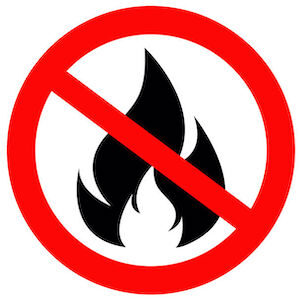By Dr. Ken Broda Bahm:

When it comes to presentation style in the courtroom, there are definitely times to “bring the fire.” Impassioned rhetoric is best used sparingly, and after you have gained your audience’s trust, but when it fits, powerful and intense delivery can help to raise the emotional stakes, and potentially help jurors feel some righteous anger. That won’t translate to all cases, and in all likelihood, not to all media either. Increasingly during this pandemic, attorneys are heading to Zoom for hearings, arbitrations, bench trials, and even jury trials. And on the small screen, there are good reasons to believe that an overly “hot” style will not communicate well.
This past week saw the conclusion of the Online Courtroom Project and National Institute for Trial Advocacy summit on “COVID, The Courts, and the Future of the Jury Trial.” At Friday’s first panel, Judge Brad Seligman of Alameda County Superior Court in California, commented on the constraints: “As Marshall McLuhan once said, this is a cool medium, not a hot medium. It benefits a lawyer to be more conversational than the stem-winder, old-style fire and brimstone type of oratory, because you are literally in the jurors’ face.” His co-panelist, David Ongaro, Partner with Ongaro PC, agreed that, “Your presentation has to be different on the small screen than it is in the courtroom.” He continues, “The courtroom is like being on the big screen at a movie, where there are gestures and you can be a little bit more passionate.” With Zoom, in contrast, people have become accustomed to the medium as a way to talk to friends, family members, and colleagues, and as a result, “It is a much more conversational type of presentation.” In this post, I’ll share a few thoughts on concrete ways attorneys should limit the fire in their style while advocating via Zoom.
‘Too Hot’ Behaviors to Avoid
Here are a few of the techniques that might be in your arsenal, but need to be reduced or eliminated on Zoom:
-
- Continuous gestures: Within the small box created by the camera, small movements look big, and continuous hand movements look crazy.
- Pacing: Obviously, it is harder to move while staying on camera, but even if you can stay in frame, even small movements (like shifting weight from one side to the other) can look nervous and erratic.
- Shouting: A raised voice might effectively fill a courtroom, but can look unhinged, or overwhelm the microphone on a Zoom call.
- Pointing: In the camera’s range, there is nothing to point at. The graphics, as well as any people you might be accusing, are in another window.
- Smacking the table or lectern: This is something to avoid anytime you have a microphone, since even a soft tap on the table gets irritatingly amplified.
- Sarcasm: When we don’t have the physical context to humanize the interaction, rhetorical tactics like sarcasm or insults can come across as aggressive and inappropriate.
- Dramatic pauses: You want some variety in your pace, but a long pause on Zoom causes “technology anxiety,” as listeners worry that they’ve lost their audio.
Different Energy, Not Less Energy
None of this advice suggests that it is a good idea to be “low energy” during your Zoom presentation. While your full rhetorical fire won’t translate well to the small screen, you do still want to be dynamic and engaging. In fact, to combat the well-known “Zoom Fatigue,” you may need to be more so.
One way to do that is with your voice. Matteo Cassese, writing at Presentation Hero, notes, “During virtual presentations, your audience will focus on your voice. You should change your pitch, speed, tone, and delivery style with what you’re presenting. Avoid being monotonous. And never read.” So practice presenting in a way that is generally slow and even, but also has some variety in pace. Vary your pitch as well and put emphasis on the key words so you aren’t speaking in a monotone. Use notes when you need to, but don’t use a script — even if your listeners can’t see it, they can hear it in your voice. Your face should be active and engaged, but not exaggerated. And, when speaking, make sure you are looking at the camera, and not at the other windows.
One factor that web conferencing provides, that is both good and bad, is the self-view: It is like performing in front of a mirror. For some people, that is a distraction and carries too much self-consciousness. If that is you, then turn off your self-view. But if you’re not distracted, then that window can provide a good reminder to occasionally check on how you look and are coming across. You should aim for a calm, conversational, and confident appearance, while still sounding dynamic and engaged.
______
______
Other Posts on Presenting Via Web-Conference:
- Before Your Next Web-Conference, Fix Your Camera Position
- Web-Conferencing? Don’t Let Your Energy Zoom Away
- Prepare for Your Zoom Hearing